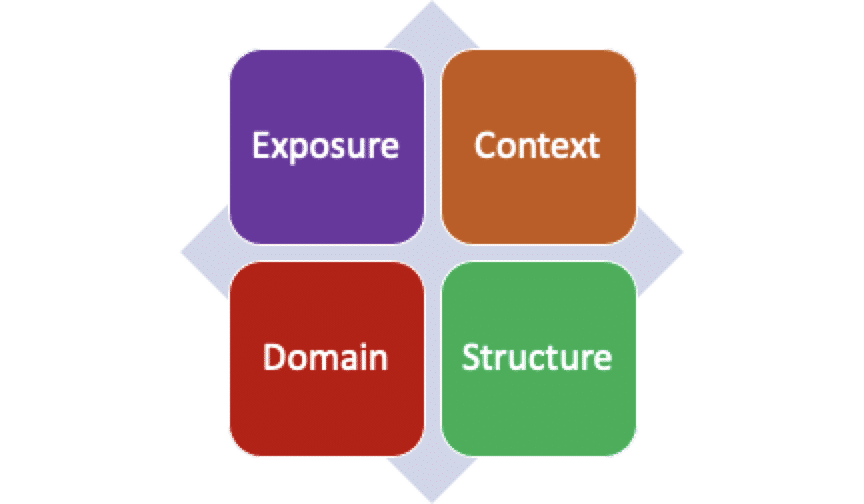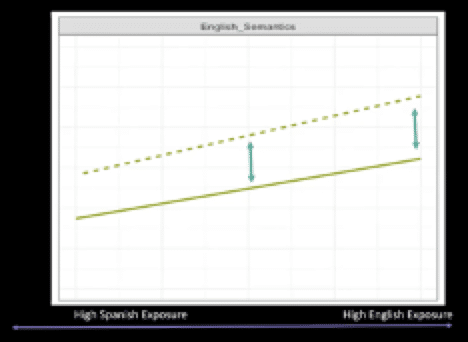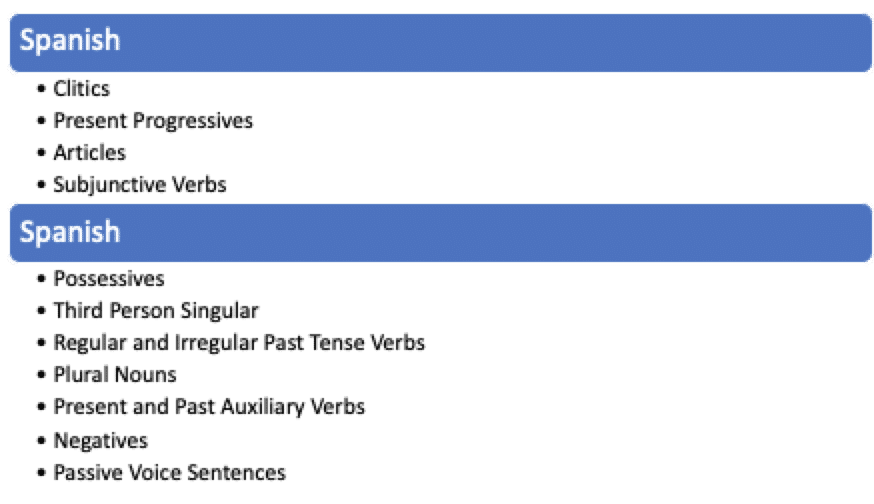What do we have to think about when we are conducting bilingual language evaluations to determine whether a child has Developmental Language Disability? Dr. Elizabeth Peña of the University of California, Irvine shares her thoughts.
The process of evaluating bilingual students is complex and there are a lot of considerations that need to be taken into account in order for us to accurately identify whether a true developmental language disability exists or not. Dr. Elizabeth Peña shares four important considerations, including language exposure, the context in which language is learned, language domain, and the structure of the languages.

Exposure
When we are evaluating bilingual children it is important to know how much exposure they have had to their two languages. The reason this is important is that research indicates that some types of test items are better at differentiating students with more English exposure, and other types of test items are better at differentiating more balanced bilinguals or students with more Spanish exposure (Bedore, Peña, Anaya, Nieto, Lugo-Neris, & Baron, 2018). More on this later.
What do we mean by language exposure?
There are two ways we can look at language exposure: age of first exposure and current exposure.
Age of first exposure tells us how many years a student has been exposed to a given language.
Current exposure considers what a typical day looks like, including who the child spends time with and what language they use together. It gives us an idea of the percentage of time a child is exposed to their languages. There are a lot of tools that are available to explore this, including:
- The Bilingual Input Output Survey (BIOS), which is part of the Bilingual English Spanish Assessment (BESA). It walks you through what a typical day looks like and helps you gather information about who speaks what language to the child. You can then calculate percentages.
- The Leaders Project Language/Dialect Acquisitional History in The Critical Questions survey Proficiency Questionnaire.
- Parent Questionnaire for Language History
- Language History Form
How does first exposure affect how children perform on measures of morphosyntax and semantics?
Age of exposure matters in bilingual language evaluations. As noted in the following graph, research indicates that:
- If you started learning English early on, your score on an English measure is going to be higher.
- If you started learning English later, your score on an English measure is going to be lower.

Current exposure matters more than age of first exposure in bilingual language evaluations but age of first exposure does matter. Note tough, how shallow the dips. Age of first exposure matters but maybe not so much. Current exposure (see graph below) better predicts what children are able to do than age of first exposure.

Language Domain
On measures of semantics, the differences between children with and without developmental language disorder are smaller for children with more balanced exposure to two languages. This suggests an advantage for bilingualism for children with DLD. In the graphs below, children with typical development are represented by the dashed lines and children with DLD are represented by the solid lines. In each domain (Spanish Syntax, English Syntax, Spanish Semantics, and English Semantics, those with DLD are lower than their peers with typical development across all levels of language exposure.
Peña and colleagues (2020) looked at 500 children with and without language disorder who had a range of exposure to Spanish and English, ranging from all Spanish to all English. When evaluating bilingual children, the difference in performance between children with and without developmental language disorder stays stable over the range of exposure from monolingual to bilingual.
Does exposure to two languages increase risk for developmental language disorder?
To sum this up, you see consistent differences between children with DLD and children with typical development OR you see a small advantage for children who are bilingual AND have a language impairment.



You’ll often hear people say that someone has suggested to them that they only use one language with their children who are struggling to learn language. The research does not support that advice. To put is simply, Dr. Peña says,
“Exposure to two languages does not make DLD worse.”
Or, put another way,
“Encouraging a monolingual environment for children with DLD does not make DLD better.” We also need to consider the opportunities a child might miss out on if they only speak one language.
Context

The context in which children learn language matters when conducting a bilingual language evaluation. We want to know where they use their languages, who they use those languages with, and what kinds of things they talk about in their two languages. A good example of this is dual language programs that divide languages by subject. For example, Science and Math are taught in one language and Language Arts and Social Studies are taught in the other. Children who learn in this context, will acquire science and math vocabulary in English and language arts and social studies vocabulary in math. Because every bilingual child has variations in how they use languages across different contexts, their profiles can look very different.
Research shows that children who are bilingual often have mixed dominance across different language tasks (Peña and colleagues, 2020). In other words, some children may perform better in Spanish on some tasks and better in English on other tasks. In a study of 600 kids, only 18 had balanced performance in both languages—that’s only 3%. In another study of 2nd and 4th graders, Peña and colleagues (2020) found that 64% demonstrated mixed dominance.
What does this mean for testing? We cannot expect that children will be stronger across the board in one language or the other. We might see profiles in which students are stronger in one language receptively, and the other expressively. We might also see profiles in which students are stronger in semantics in one language and syntax in the other. This is why it is important that we do not make assumptions based on a small portion of our testing when conducting a bilingual language evaluation.
Structure
Different types of items in English and Spanish best differentiate children with developmental language disorder from children with typical development. Peña and colleagues (2020) found that In Spanish, items that test clitics, present progressives, articles and subjunctive verbs did the best job of differentiating these those with and without developmental language disorder. In English, items that tested possessives, third person singular, regular and irregular past, plural nouns, present and past auxiliary verbs, copula verbs, negatives, and passive voice sentences best differentiated the groups.
How does language structure impact patterns of performance in bilingual language assessments?
Peña and colleagues (2020) found that these types of items best differentiated those with and without developmental language disorders in Spanish and English, respectively.

For semantics, vocabulary is very subject to experience. For this reason, it is important to explore what people can do with words not just what words they know. We want to explore what their semantic network looks like and whether they make associations between the words they know. Dr. Peña shared that In Spanish, successful items were those that tested linguistic concepts, categorization, and functions. In English, items related to similarities and differences, and categorization items worked well.

And more on how language context affect patterns of performance in a bilingual language evaluation…
In a study of word knowledge, McMillen and colleagues (2020) found that on the EOWPVT some items were easier for bilingual children in English (chess, telescope, skateboard, compass, binoculars, some were easier in Spanish (bird, kite, bus, leaf, clothes, wheelbarrow), and some were of equal difficulty (flying, dentist, fruit, penguin). Words that were easier in English included words commonly learned at school, words that were easier in Spanish were words commonly used at home. This is another illustration of how context matters.
We can’t discuss assessment of bilingual children without answering the question:
Can we test bilingual children in English only?
It depends, says Dr. Peña. Ideally, we would test all bilingual children in both of their languages all of the time. But, we also need to acknowledge the shortage of bilingual evaluators, and the long amounts of time that many children have to wait for an evaluation. So, if we have to pick some children to be tested in English only, we need to do it strategically.
Bedore and colleagues (2018) found that different types of items yield high levels of sensitivity and specificity for different exposure groups (English dominant, Balanced Bilingual, Spanish Dominant).
Let’s first define the groups in the study.
- English dominant: English exposure 60% or more of the time
- Balanced Bilinguals: Exposure to both languages at least 40% of the time
- Spanish dominant: Spanish exposure 60% or more of the time
Bedore and colleagues (2018) considered items to be good differentiators if there was at least a 30% difference in scores between those with and without DLD.
The chart below demonstrates the types of items in English that worked well for at differentiating those with and without DLD for each group, distinguished by current language exposure.
English items that differentiated those with and without DLD when testing bilingual children
| Item Type | Example | English Dominant | Balanced Bilinguals | Spanish Dominant |
| Passive Voice | The boy was hugged by the girl. | ✔ | ✔ | ✔ |
| 3rd Person Singular | Runs | ✔ | ✔ | ✔ |
| Possessives | Teacher’s | ✔ | ✔ | ✔ |
| Question Inversion | Is the bus at the school? | ✔ | ✔ | ✔ |
| Plural Noun | Boxes | ✔ | ✔ | |
| Regular Past | Dropped | ✔ | ✔ | |
| Negative | Don’t burn the toast. | ✔ | ✔ | |
| Copula | He is tall. | ✔ | ✔ | |
| Relative Clause | …that was on the stove | ✔ | ✔ | |
| Irregular Past Tense | Broke | ✔ |
“This is telling us that maybe it’s possible to test kids in English but we have to use the right items in the right context.” Liz Peña
How do we use this information in the bilingual assessment process?
Let’s say you administer the English portion of the BESA or another test in English to a student who has more Spanish exposure than English exposure (Spanish Dominant) and they missed items related to plural nouns and regular past tense verbs in English. If we know that these types of items do not differentiate those with and without Developmental Language Disorder well for children at this level of exposure, we need to let that inform our clinical judgment. Analyze the items that were missed and compare them to this chart. If an English Dominant student struggles with possessives, passive voice, plural nouns, and irregular past tense, we know that those are all items that do differentiate these groups well, so such performance is likely indicative of DLD. This is another tool in our belt that we can use to build our diagnostic decisions.
Question and Answer Session
At the end of Dr. Peña’s talk at the Bilinguistics Virtual Conference on Cultural and Linguistic Diversity, participants had the opportunity to ask questions. Below are some highlights from the Q&A session.
At what level of current exposure can we feel confident in testing bilingual students only in English?
Once children have current exposure around 70% or more we get really reliable results testing them only in English. And we’ve found the same thing for Spanish.
“We’ve tested thousands of kids in both languages, and we’re finding that 70% is a pretty reliable cutoff for testing only in one language.” So if you, if you test a kid and they present as being pretty dominant in English and they test within the normal range, then testing in their home language isn’t going to change your diagnostic decisions. So I think you can stop.
Or if they present as being Spanish dominant and you test them in Spanish and that’s within normal range, you can make your diagnostic decision then without doing further testing.
It’s when they test in the impaired range that we can’t make a diagnostic decision without looking at the other language, at least informally. That’s because if they scored better than the other language, then it could change your diagnostic decision.
But if they’re above 70% exposure, then testing in the other language probably won’t show better performance, and it will be unlikely to change the decision.
How do we apply the principles for Spanish-English bilingual language evaluations discussed here to other languages?
That’s a great question. And I think that one of the things that we have to think about and is what’s difficult for that language. So not everything, especially in the grammatical domain, not everything’s going to translate in the same way. So what are the features or the structure of that language and what are the things that are the most vulnerable to learning.
We probably have to use language samples or narrative samples in that language, but focus on the structure of the narrative, as well as looking at whether they’re making grammatical errors that are unexpected for that age because that’s usually the best marker of impairment across different languages. One tool for doing this is the Multilingual Assessment Instrument for Narratives. It’s available in a bunch of different languages and it’s free. They look at two levels. One is narrative structure, and then the other is micro structure. So can they use the format, the expected grammatical elements for that language it’s not available in every language in the world, but it’s all available in quite a number of languages.
Is a Silent Period expected for children learning a second language?
So there are some reports around what some people call the silent period. Some people have observed cases where when children first get exposed to a second language in a classroom setting and everybody’s speaking English around them, and that are the only one who doesn’t speak English. And it’s fairly rare is the thing. And so this is where I think that we have to go beyond case studies and look at trends. There was report done by Roberts in 2014 called Not so silent after all (Roberts, 2014). It’s a meta-analysis of studies about the silent period, where they found that in many cases, it was a small group of children. It wasn’t the case that all bilingual children or all second language learners went through this. Most actually didn’t go through a silent period. And, for those who did, that period of time lasted from a few days to a couple of weeks. So it’s not an extended period of time. If this goes on for a long time, more than a couple of weeks, then something might be going on and I would start to ask them questions. It could be anxiety. It could be individual differences. It could be part of the normal silent period. It could be a flag for DLD.
References
- McMillen, S., Anaya, J. B., Peña, E. D., Bedore, L. M., & Barquin, E. (2020). That’s hard! Item difficulty and word characteristics for bilinguals with and without developmental language disorder. International Journal of Bilingual Education and Bilingualism, 1-19.
- Bedore, Peña, Anaya, Nieto, Lugo-Neris, & Baron (2018). Patterns of Language Impairment in the Context of English as a Second Language. Language, Speech, and Hearing Services in the Schools, 49(2), 277-291.
- Peña, E. D., Bedore, L. M., Lugo-Neris, M. J., & Albudoor, N. (2020). Identifying developmental language disorder in school age bilinguals: Semantics, grammar, and narratives. Language Assessment Quarterly, 17(5), 541-558.
- Roberts, T. A. (2014). Not so silent after all: Examination and analysis of the silent stage in childhood second language acquisition. Early Childhood Research Quarterly, 29(1), 22-40.



